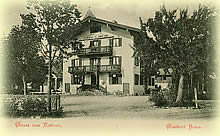Chronik
Geschichte Rottach-EgernDie Gemeinde Rottach-Egern, früher Rottach ist unter Abt Eberhardt mit Adalprecht de Rota, die beide dem 746 gegründeten Kloster Tegernsee angehörten erstmals erwähnt. Rottach-Egern war ein Fischer- und Bauerndorf und empfing seine Impulse hauptsächlich durch das Benediktinerkloster Tegernsee, das bis zur Säkularisation im Jahre 1803 bestand und durch seine Bibliothek berühmt war. Herzog Heinrich von Tirol öffnete im Jahre 1320 den Weg durchs Achental (Tirol), damit wurde Rottach in die Straße einbezogen, die eine wichtige Handelsstraße von Bayern nach Tirol und Italien war. Seit dieser Zeit bis ins 19. Jahrhundert hinein blieb der Ort im wesentlichen eine Durchgangs- und Relaisstation. Nach der Klosteraufhebung im Jahre 1803 kamen im Jahre 1817 die Wittelsbacher an den Tegernsee und mit ihnen die ersten Gäste. Es waren Minister und Staatssekretäre, Dichter und Maler und vor allem der Adel. Der Egener Friedhof ist einer der meistbesuchtesten Friedhöfe Altbayerns. Die Dichter Ludwig Thoma und Ludwig Ganghofer, der Kammersänger Lea Slezak ( dessen Skulpturen stehen im Rottacher Kurpark), die Schriftsteller Heinrich und Alexander Spoerl und der bekannte Maler Olaf Gulbransson sind hier beerdigt. Rottach-Egern ist mit heute rund 6800 Einwohnern die größte Ufergemeinde am Tegernsee und wurde 1976 als heilklimatischer Kurort anerkannt. Sie kann 3200 Gäste beherbergen. Das Gemeindegebiet von Rottach-Egern umfaßt ca 60 qkm und liegt 740-1700 Meter über dem Meeresspiegel. Der Tegernsee ist 6 km lang, ca. 2 km breit und an der tiefsten Stelle 72 m tief. |
|
|

|
Chronik Gästehaus PfatischerDas heutige Gästehaus Pfatischer wurde 1902 erbaut und als Gasthof Hahn geführt. 1906 erwarben Johann und Elise Pfatischer das Anwesen und führten den Gasthof mit eigener Metzgerei, Biergarten und Zimmervermietung in bayrischer Tradition. Ludwig Pfatischer der gelernte Metzger mit seiner Frau Katharina übernahmen sehr früh den elterlichen Betrieb. Zunächst war das Fremdenheim Pfatischer ein Erholungsheim der IG Bergbau und Kurheim der Firma Siemens bis zunehmend der Fremdenverkehr an Bedeutung gewann. Das Haus wurde mehrmals um- bzw. ausgebaut, modernisiert und erweitert. 1967 leistete Ludwig und Katharina Pfatischer Pionierarbeit mit dem Bau des ersten Hallenschwimmbades bis weit über die Landkreisgrenzen. 1990 folgte dann die Erweiterung des Wellnessbereichs mit Sauna, Dampfbad, Fitness durch den Sohn Bernd Pfatischer. Seit 1999 setzt nun Bernd und Rosi Pfatischer mit Christina und Tobias die langjährige Familientradition fort. Ende 2010 wurde der Neubau des Ferienhauses im ländlichen Stil auf dem Grundstück fertiggestellt. Dort stehen unseren Gästen Ferienwohnungen in verschiedenen Größen zur Verfügung. 2025 haben wir die Vermietung des Gästehauses aufgegeben und das Haus dauerhaft geschlossen. Die Ferienwohnungen im Landhaus jedoch stehen weiter zur Verfügung. Wir freuen uns auf nette Gäste, die unser Landhaus besuchen, sich wohlfühlen, uns weiterempfehlen und immer mal wieder bei uns vorbeischauen Ihre Familie Pfatischer |




